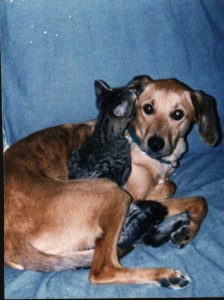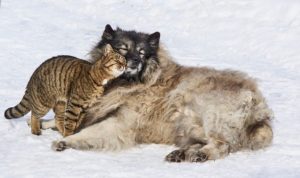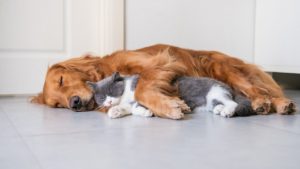
Image by rihaij from Pixabay.com
A friend’s comment about the political climate made revisiting my thoughts about fighting like cats and dogs a viable option at this time. So I decided to resurrect this commentary from 2002, add some pictures, do some editing and up-dating, and re-post it.
That human perceptions of certain animals and their interactions could reflect human feelings about comparable human behaviors is an aspect of the human-animal bond that’s long intrigued me. After revisiting the material below, I began thinking about human views of dogs, cats, and gender and the many variations on that theme. No doubt some of these thoughts will find their way into podcasts or commentaries in the future, too.
********************************

Whitman sucking Watson’s ear
To me one of the most enjoyable aspects of my work involves observing how animals normally interact with each other. And because cats and dogs are the most common domestic household pets, these supply a rich source of input. However, you don’t need to observe canine-feline interactions very long to realize that some, and possibly many, dogs and cats don’t subscribe to the antagonistic relationship described in the old saw “fighting like cats and dogs.” That raises the question of why some people wanted and some may still want to believe this.
Given the hypertext way my mind works, the idea of fighting cats and dogs gives rise to thoughts about other cat- and dog-related sayings. Immediately “man’s best friend” comes to mind, followed by the realization that no similar sentiment regarding cats so pervades our culture.
Why not? Perhaps this occurs because, relatively speaking, dogs and cats lie at opposite ends of the behavioral spectrum. More dogs probably evolved from their more solitary roots and became more social and associated with humans (or even pre-humans) earlier than cats. Meanwhile the feline-friendly environment niche suited them so well, there was no need for them to change. Add that the canine orientation toward people more closely parallels those human behavioral traits considered more socially acceptable, and this might explain why humans embraced the concept of dogs as best friends. Lord Byron is said to reflect this opinion in his Inscription on the Monument of a Newfoundland Dog, written in 1808:
Near this spot are deposited the remains of one who possessed beauty without vanity, strength without insolence, courage without ferocity, and all the virtues of Man without his vices. This praise, which would be unmeaning flattery if inscribed over human ashes, is but a just tribute to the memory of Boatswain, a dog.
And also:
The poor dog in life, the firmest friend,
The first to welcome, foremost to defend.
Let me be the first to admit that, revered though it may be, this tribute hits me like something written by a guy who’s just lost an argument with some Significant Female Other in his life: “No, George (she ditches the upscale “Lord Byron” for his first name), I will not drop everything and wash your filthy socks!” she shouts, throwing the smelly objects back at him when he drapes them over her mirror. “If they’re so important to you, you can wash them yourself.” He then storms back to his desk where he unfavorably compares this vain, insolent, and ferocious woman to the wonderful, albeit dead, dog who would never treat a man (Man?) like that.
OK, maybe it didn’t happen that way. But we do know that the best friend concept became even more entrenched when an American senator, George Graham Vest made a speech to the Senate in 1884 in which he said:
The one absolutely unselfish friend that man can have in this selfish world, the one that never deserts him, the one that never proves ungrateful or treacherous, is his dog.
…When all other friends desert, he remains.
For all I know, the Senator’s lack of clean socks may have inspired him that day too.
Still, and any valid or invalid intuitions aside, I don’t think we can overlook that these sentiments were expressed by influential men living in male-dominated societies. Consequently, it seems reasonable to think that repetition of their sentiments further reinforced the link between male humans and dogs. (Recall how little boys supposedly were made of puppy dogs’ tails, among other things, whereas little girls got stuck with the baking ingredients.) Meanwhile, from day one cats were associated with things feminine, both good or bad, apparently depending on how a particular society viewed women.

Image by Ingo Jakubke for Pixabay.com
As soon as a particular society assigns gender-related symbolism to animals, that automatically affects how members of each sex view that animal. Although I’ve been unable to confirm the fact, I suspect that “fighting like cats and dogs” most likely was some wag’s description of an argument between some man and woman based on the gender-related symbolism attached to these animals at that time. Once that occurred, then other people began interacting with these animals in a way that supported this belief. For example, people (most likely males) would emit a canine-fear-arousing hiss “Sic ’em!” when a cat approached, and then praise the dog when the dog displaced his fear-based aggression on the cat instead of the human source of the sound.
Fortunately for the human as well as nonhuman animal species, not everyone bought—or buys—into the myths projected on certain species of animals. Somehow a few individuals always manage not to lose sight of animals as unique beings worthy of respect in the midst of even the most widespread and enthusiastic projected human symbolism. The most basic knowledge of animal behavior makes it clear that, for all the talk of fighting cats and dogs, it makes a lot more sense for dogs and cats to mix it up with members of their own species than those of the other.
Since the 1960’s and 70’s (possibly related to the women’s liberation movement and, no, I don’t want to go there!), the pressure for people to align themselves with one species or the other thankfully has waned. Some dogs may be some men’s best friends and some women’s, as may some cats. But more and more animal lovers unashamedly admit they feel that way about members of both species. That, in turn, results in more opportunities to watch members of these two species interact…
Which triggered these ruminations in the first place
And on that note, I’ll conclude this commentary and go back to watching my cat “fish” for the dogs, using his tail as a lure when they approach the couch beneath which he lurks. The corgi tries to stomp the tail with her fat feet and the cat accommodates her with shorter sweeps that keep it just out of her reach. When the far more studious and perhaps not quite so bright hound plays the game, the cat holds his tail still long enough for the dog to grasp what’s going on. If the dog takes too long, though, the cat suddenly will fly out from under the couch and the chase is on. The cat chases the hound and the corgi chases the cat.
And there they go, my best animal friends, playing like cats and dogs.
That era ended in 2004 when Violet the Wonderdog moved on into eternity. Since then other cats and dogs have lived in the little house on hill and filled that inter-species niche. There may have been exchanges of canine-feline profanity on occasion, but nothing that ever threatened their relationships as each others’ best friends.

Image by Bao_5 from Pixabay.com
Image by rihaij from Pixabay.com
A friend’s comment about the political climate made revisiting my thoughts about fighting like cats and dogs a viable option at this time. So I decided to resurrect this commentary from 2002, add some pictures, do some editing and up-dating, and re-post it.
That human perceptions of certain animals and their interactions could reflect human feelings about comparable human behaviors is an aspect of the human-animal bond that’s long intrigued me. After revisiting the material below, I began thinking about human views of dogs, cats, and gender and the many variations on that theme. No doubt some of these thoughts will find their way into podcasts or commentaries in the future, too.
********************************
Whitman sucking Watson’s ear
To me one of the most enjoyable aspects of my work involves observing how animals normally interact with each other. And because cats and dogs are the most common domestic household pets, these supply a rich source of input. However, you don’t need to observe canine-feline interactions very long to realize that some, and possibly many, dogs and cats don’t subscribe to the antagonistic relationship described in the old saw “fighting like cats and dogs.” That raises the question of why some people wanted and some may still want to believe this.
Given the hypertext way my mind works, the idea of fighting cats and dogs gives rise to thoughts about other cat- and dog-related sayings. Immediately “man’s best friend” comes to mind, followed by the realization that no similar sentiment regarding cats so pervades our culture.
Why not? Perhaps this occurs because, relatively speaking, dogs and cats lie at opposite ends of the behavioral spectrum. More dogs probably evolved from their more solitary roots and became more social and associated with humans (or even pre-humans) earlier than cats. Meanwhile the feline-friendly environment niche suited them so well, there was no need for them to change. Add that the canine orientation toward people more closely parallels those human behavioral traits considered more socially acceptable, and this might explain why humans embraced the concept of dogs as best friends. Lord Byron is said to reflect this opinion in his Inscription on the Monument of a Newfoundland Dog, written in 1808:
And also:
Let me be the first to admit that, revered though it may be, this tribute hits me like something written by a guy who’s just lost an argument with some Significant Female Other in his life: “No, George (she ditches the upscale “Lord Byron” for his first name), I will not drop everything and wash your filthy socks!” she shouts, throwing the smelly objects back at him when he drapes them over her mirror. “If they’re so important to you, you can wash them yourself.” He then storms back to his desk where he unfavorably compares this vain, insolent, and ferocious woman to the wonderful, albeit dead, dog who would never treat a man (Man?) like that.
OK, maybe it didn’t happen that way. But we do know that the best friend concept became even more entrenched when an American senator, George Graham Vest made a speech to the Senate in 1884 in which he said:
For all I know, the Senator’s lack of clean socks may have inspired him that day too.
Still, and any valid or invalid intuitions aside, I don’t think we can overlook that these sentiments were expressed by influential men living in male-dominated societies. Consequently, it seems reasonable to think that repetition of their sentiments further reinforced the link between male humans and dogs. (Recall how little boys supposedly were made of puppy dogs’ tails, among other things, whereas little girls got stuck with the baking ingredients.) Meanwhile, from day one cats were associated with things feminine, both good or bad, apparently depending on how a particular society viewed women.
Image by Ingo Jakubke for Pixabay.com
As soon as a particular society assigns gender-related symbolism to animals, that automatically affects how members of each sex view that animal. Although I’ve been unable to confirm the fact, I suspect that “fighting like cats and dogs” most likely was some wag’s description of an argument between some man and woman based on the gender-related symbolism attached to these animals at that time. Once that occurred, then other people began interacting with these animals in a way that supported this belief. For example, people (most likely males) would emit a canine-fear-arousing hiss “Sic ’em!” when a cat approached, and then praise the dog when the dog displaced his fear-based aggression on the cat instead of the human source of the sound.
Fortunately for the human as well as nonhuman animal species, not everyone bought—or buys—into the myths projected on certain species of animals. Somehow a few individuals always manage not to lose sight of animals as unique beings worthy of respect in the midst of even the most widespread and enthusiastic projected human symbolism. The most basic knowledge of animal behavior makes it clear that, for all the talk of fighting cats and dogs, it makes a lot more sense for dogs and cats to mix it up with members of their own species than those of the other.
Since the 1960’s and 70’s (possibly related to the women’s liberation movement and, no, I don’t want to go there!), the pressure for people to align themselves with one species or the other thankfully has waned. Some dogs may be some men’s best friends and some women’s, as may some cats. But more and more animal lovers unashamedly admit they feel that way about members of both species. That, in turn, results in more opportunities to watch members of these two species interact…
Which triggered these ruminations in the first place
And on that note, I’ll conclude this commentary and go back to watching my cat “fish” for the dogs, using his tail as a lure when they approach the couch beneath which he lurks. The corgi tries to stomp the tail with her fat feet and the cat accommodates her with shorter sweeps that keep it just out of her reach. When the far more studious and perhaps not quite so bright hound plays the game, the cat holds his tail still long enough for the dog to grasp what’s going on. If the dog takes too long, though, the cat suddenly will fly out from under the couch and the chase is on. The cat chases the hound and the corgi chases the cat.
And there they go, my best animal friends, playing like cats and dogs.
That era ended in 2004 when Violet the Wonderdog moved on into eternity. Since then other cats and dogs have lived in the little house on hill and filled that inter-species niche. There may have been exchanges of canine-feline profanity on occasion, but nothing that ever threatened their relationships as each others’ best friends.
Image by Bao_5 from Pixabay.com